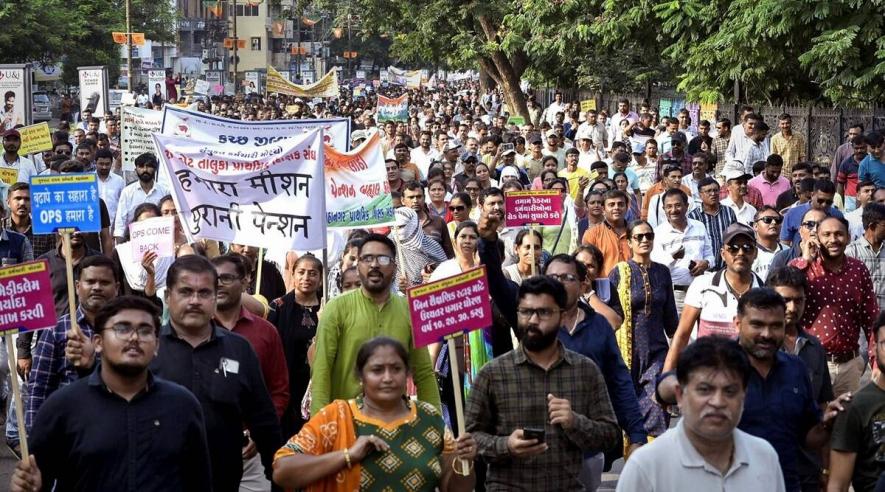Why Can’t a ‘Fastest Growing Economy’ Give Universal Pension and OPS?

Government employees under the banners of Gujarat State Employees Mahamandal and Gujarat State United Employees Front participate in a protest march over various demands including restoration of the old pension scheme, in Rajkot, September 11, 2022. Image Courtesy: PTI(File Image)
We observe a strange phenomenon every day, so strange that its strangeness goes generally unnoticed. Government spokespersons from the Prime Minister downward go on repeating ad nauseam that India is the most rapidly growing major economy in the world today, that it will soon become a $5 trillion economy, and that it has overtaken China in terms of the growth rate of the gross domestic product.
And yet, the same government spokespersons claim that the government has no money to pay for the old pension scheme (OPS) for government employees, let alone for a proper universal non-contributory pension scheme for the millions who spent their working years as employees in the unorganised sector.
The world’s “fastest growing economy”, it appears, cannot afford pensions for its old, just as it cannot afford an adequate diet for its female population, since 57% of women between the ages of 15 and 49, according to the National Family Health Survey, suffered from anaemia in 2019-21 (up from 53% in 2015-16).
Likewise, this so-called “fastest growing economy” of the world cannot provide adequate nutrition to its population in general, because of which it ranks 111th in the world hunger index among the 125 countries for whom the index is calculated. And the proportion of rural population that cannot access the minimum norm of 2,200 calories per person per day that the old Planning Commission had taken as the benchmark for rural poverty, has risen from 68% in 2011-12 to well over 80% in 2017-18, according to data made available by none other than the National Sample Survey.
Let us probe matters a little further.
The only argument advanced by its defenders for the new pension scheme over the old scheme for government employees is the fiscal argument; and it is taken to be almost axiomatic. The moment one mentions the old scheme, the immediate response of most media persons and economists, almost as a reflex action, is: “But the government cannot afford it”.
Now, under the old scheme, a government employee after retirement, received half of the last salary-cum-dearness allowance as pension, and this was adjusted subsequently for inflation (in sync with the DA (dearness allowance) of government employees in service). When adjusted for inflation, the “real” pension remained more or less constant until very occasionally updated after several years.
Now, if the economy is growing in “real” terms by 6% to 7% per annum, as the government boasts, then, since the number of pension-earning government employees is not growing at this rate, and since any increase in real pension occurs, if at all, only after a considerable time lag, the pension amount as a proportion of GDP should be falling over time (until any real revision occurs and that can best bring it back to its original level).
In other words, far from the pension amount becoming unsustainable over time, it should be actually falling in proportionate terms over time, and hence becoming easier to accommodate, if the government’s own growth figures are taken seriously. But then why is the government claiming the contrary?
The reason cannot lie in the fact that while GDP (gross domestic product) growth is occurring at a rapid rate, the government’s fiscal is somehow constrained from expanding at the same rate, for there is no earthly reason why this should be so.
The real reason then must be that the government simply wants ever larger proportions of the GDP to go the capitalists and the rich, for which it can always advance the convenient argument that such transfers help boost investment and hence GDP growth.
There is, however, no justification for this argument: the usual claim that if more money is given to capitalists they would invest more, is a jejune one whose vapidity was exposed almost a century ago by none other than the bourgeois economist J M Keynes, who, along with the Polish Marxist economist Michal Kalecki, showed that capitalism is generally a “demand-constrained system”.
In such a system, output, investment and growth are boosted by increasing aggregate demand, and not by making transfers to capitalists. This proposition has been so clearly demonstrated to be true by experience that even the Modi government cannot possibly believe in its veracity. Its refusal to make more resources available for pensions, whether for its own employees or for the aged population in general, is a clear demonstration of class-bias, having nothing to do with any sane economic logic.
The government’s crowing over the growth rate even in the midst of acute distress, and its refusal to alleviate this distress in the name of boosting the GDP, in short, this entire GDP-fetishism contains an absurdity whose limit was reached under the rule of the maharajahs of yore. Many of them used begaar or corvee labour, where labour is forced out of the labourer without any payment being made to him, to build palaces for themselves. Such construction would have shown itself as a high growth rate of GDP, even though the oppression inflicted on the people was inhuman. A GDP-fetishist, therefore, should have been proud of begaar.
Likewise, we have today crores of old people being pushed into inhuman conditions of life, with only a tiny proportion of them being a paid a pittance of Rs 200 per month per person by the Central government, not because there are no resources in the country to improve their lot but because resources are appropriated by the capitalists and the rich in general, using an utterly spurious argument that their doing so would boost GDP growth.
Let us look at this question of resources a little more carefully. In 2018-19, there were approximately 13 crore persons above the age of 60 who needed a living pension of roughly Rs 3,000 per month. In that year, the gross national income of the country in round figures was Rs 187 lakh crore, or Rs 187 trillion. The payment of Rs 3,000 per month to the old persons, therefore, would have required no more than 2.5% of the GNI.
The payment of pension would result in expenditure, a part of which would accrue to the government in the form of taxes and hence can be re-spent. Assuming on a conservative basis that 30% of such spending accrues back to the government after all the rounds of the multiplier have been completed (that is, expenditure generating output and incomes and hence further expenditure and further output and incomes, and so on, with taxes being paid in each round, has finally been completed), a total expenditure of 2.5% of the GNI would require an initial injection of demand amounting to only 1.75% of the GNI into the economy.
Assuming, not unrealistically, that when the rich pay larger taxes, they do not necessarily stint on their consumption (unless the taxes are extraordinarily heavy), this amount can be raised comfortably by imposing a wealth tax of only 1% on just the top 1% of the population. It follows, therefore, that there is no dearth of resources in the country for instituting a universal, non-contributory pension programme, from which those who are already on some pension scheme (and presumably getting more than Rs 3,000 per month at 2018-19 prices) will voluntarily drop out.
Surely, it would be thought, the number of potential pensioners would have increased by now compared with 2018-19, and because of inflation the amount of Rs 3,000 per month would have to be revised upward; wouldn’t the fiscal strain today be heavier? The answer is “no”, because meanwhile the national income in current prices too has increased, both because of real growth and also because of the price-rise that raises nominal national income.
In fact, since the number of potential beneficiaries would not have grown at the same rate as the real national income, the provision of the same amount of “real” pension (Rs 3,000 per month at 2018-19 prices), would require a lower share of national income, and hence an even smaller fiscal effort.
There is a further benefit from such a scheme, apart from the succour with dignity it provides to human beings. With neo-liberal capitalism reaching a crisis of over-production, greater State expenditure, financed either by a fiscal deficit or by taxes on the rich, is urgently required to overcome the crisis.
Neo-liberalism, however, is opposed both to a larger fiscal deficit and to larger taxes on the rich, which is why there is no solution to the crisis within neo-liberalism itself. Measures like a universal non-contributory pension scheme constitute in this context a way of overcoming the crisis and the harbingers of a new order.
Get the latest reports & analysis with people's perspective on Protests, movements & deep analytical videos, discussions of the current affairs in your Telegram app. Subscribe to NewsClick's Telegram channel & get Real-Time updates on stories, as they get published on our website.
























